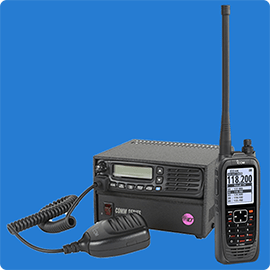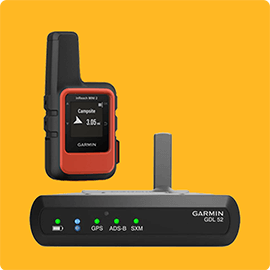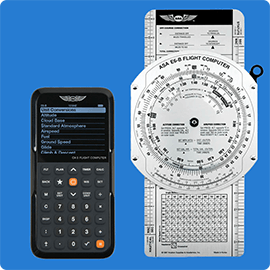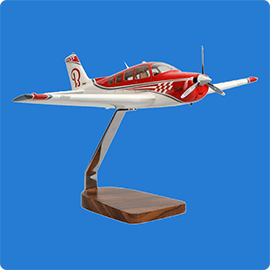Guía para principiantes sobre el uso de IA en la aviación general
Aprenda a optimizar sus vuelos de aviación general con herramientas de IA, desde la planificación previa al vuelo hasta la asistencia en cabina en tiempo real. Explore consejos prácticos, compare plataformas GPT populares y descubra las mejores prácticas para integrar la IA de forma segura en su rutina de vuelo.
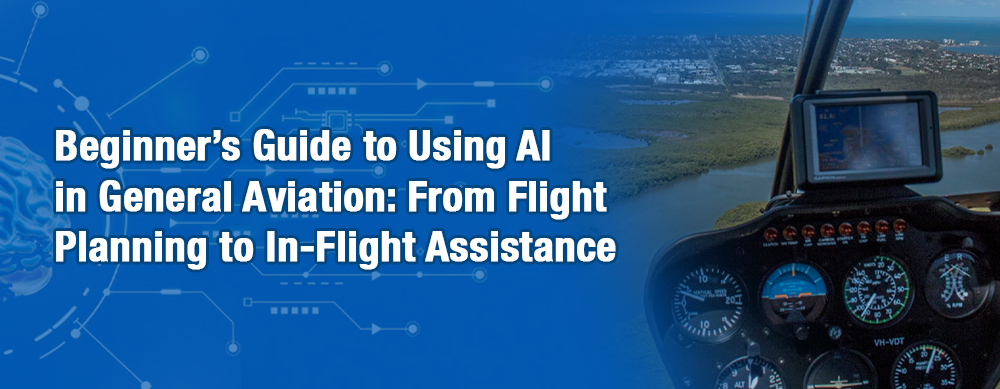
Featured Pilot Gear
Browse our selection of high-quality pilot supplies! Your purchase directly supports our small business and helps us continue sharing valuable aviation content.
Una nueva era de asistencia inteligente se vislumbra en los cielos, y es más accesible de lo que imagina. Esta guía desmitifica la Inteligencia Artificial para el piloto de aviación general, ofreciendo una guía práctica para usar esta poderosa nueva tecnología como copiloto de confianza.
Tabla de contenido
- ¿Qué es la IA y por qué es importante para los pilotos?
- Áreas clave en las que la IA puede ayudar a los pilotos de aviación general
- Paso a paso: Cómo empezar a usar herramientas de IA
- Una comparación de las principales plataformas de IA para pilotos
- Escenarios del mundo real: IA en acción
- Mejores prácticas y limitaciones
- Preguntas frecuentes
- Conclusión y llamada a la acción
¿Qué es la IA y por qué es importante para los pilotos?
En el contexto de la aviación general, la Inteligencia Artificial (IA) se refiere a software sofisticado, a menudo en forma de asistentes "chatbot" o herramientas de aprendizaje automático, capaces de procesar grandes cantidades de información, comprender el lenguaje humano y proporcionar respuestas perspicaces y prácticas. Considérelo un asistente superinteligente capaz de analizar conjuntos de datos complejos —desde mapas meteorológicos y tablas de rendimiento hasta extensas regulaciones federales— y descomponerlos en información clara y concisa.
Para el piloto moderno, la relevancia de la IA es evidente: ofrece un aumento significativo en la eficiencia y la seguridad. Imagine un asistente que pueda trazar una ruta de vuelo óptima y, al mismo tiempo, resumir todos los NOTAM y TFR pertinentes, o una herramienta que pueda traducir una serie de METAR y TAF en un informe meteorológico claro para toda su ruta de vuelo. Este es el poder de la IA. Actúa como un incansable copiloto digital, ahorrándole tiempo en tierra, mejorando su conocimiento de la situación en el aire y ayudando a mitigar el error humano al detectar detalles que podría haber pasado por alto. Además, la IA está demostrando ser una herramienta revolucionaria para el estudio, capaz de explicar conceptos aerodinámicos complejos o de hacerle preguntas sobre procedimientos de emergencia en cualquier momento del día. En definitiva, la IA amplía sus capacidades, permitiéndole ser un piloto más informado y preparado.
Áreas clave en las que la IA puede ayudar a los pilotos de aviación general
Los pilotos descubren continuamente nuevas e innovadoras formas de integrar la IA en sus rutinas. Estas son algunas de las áreas clave donde estas herramientas ya están teniendo un impacto significativo:
- Planificación de vuelo: La IA puede ser revolucionaria en la planificación de rutas, la selección de altitud y el cálculo de combustible. Un asistente de IA puede generar una ruta VFR o IFR optimizada que considera el terreno, el espacio aéreo, los vientos en altura y el rendimiento de la aeronave. También puede consolidar toda la información necesaria previa al vuelo en un único informe de fácil lectura. Si bien esta información siempre debe verificarse con fuentes oficiales, la IA puede realizar el trabajo inicial más complejo en muy poco tiempo.
- Informe y análisis meteorológico: En lugar de descifrar manualmente los datos meteorológicos sin procesar, puede solicitar a una IA que le proporcione un resumen completo en lenguaje sencillo. Estas herramientas pueden interpretar patrones meteorológicos complejos, identificar posibles peligros como la formación de hielo o tormentas eléctricas a lo largo de su ruta y ayudarle a tomar decisiones más informadas sobre si seguir adelante o no.
- Asistencia en Vuelo y Apoyo a la Toma de Decisiones: En la cabina, los asistentes de voz con IA pueden reducir significativamente la carga de trabajo del piloto. Estas herramientas pueden repasar verbalmente listas de verificación, obtener información del aeropuerto o frecuencias mediante comandos, e incluso responder preguntas operativas. Por ejemplo, podría preguntar: "¿Cuáles son los mínimos meteorológicos VFR en el espacio aéreo de Clase G por la noche?" y recibir una respuesta inmediata y precisa.
- Informe posterior al vuelo y gestión del libro de registro: La IA también se está haciendo un hueco en el análisis posterior al vuelo. Están surgiendo herramientas que pueden analizar los datos de vuelo, detectando inconsistencias en maniobras como virajes pronunciados o aproximaciones inestables, y proporcionando retroalimentación objetiva para complementar la información del instructor. La IA también puede ayudar a redactar entradas detalladas en el libro de registro, resumiendo los aspectos clave del vuelo.
- Ayudas de entrenamiento y estudio: La IA es como tener un instructor personal en tierra disponible las 24 horas, los 7 días de la semana. Puedes pedirle que te explique regulaciones complejas con palabras sencillas, que cree un plan de estudio personalizado para un próximo vuelo de verificación o incluso que te conviertas en un controlador de tráfico aéreo para practicar tus comunicaciones por radio. Las aplicaciones especializadas incluso pueden buscar en los manuales oficiales de la FAA para obtener respuestas citadas a tus preguntas.
Paso a paso: Cómo empezar a usar herramientas de IA
Integrar la IA en su flujo de trabajo de aviación es un proceso sencillo. Aquí tiene una guía sencilla para empezar:
- Identifica tus necesidades: Determina con qué necesitas más ayuda. ¿Será la planificación de vuelo, que requiere mucho tiempo? ¿Quieres una referencia rápida de las regulaciones? ¿O una forma más interactiva de estudiar para tu próxima habilitación? Conocer tu objetivo principal te ayudará a elegir la herramienta adecuada.
- Elige tu plataforma: Comienza con un chatbot de IA de uso general y ampliamente disponible, como ChatGPT o Gemini de Google . Se puede acceder a ellos a través de sus sitios web y aplicaciones móviles, y son sorprendentemente capaces de responder preguntas relacionadas con la aviación. A medida que te familiarices con ellos, puedes explorar herramientas específicas para la aviación.
- Aprende a dar indicaciones: La clave para sacar el máximo provecho de la IA es aprender a hacer buenas preguntas (indicaciones). Sé claro y específico. Por ejemplo, en lugar de "planificar un vuelo", prueba "Planificar un vuelo VFR de KORL a KSSI en un Cessna 172, con salida prevista para mañana a las 10:00. Proporciona una altitud de crucero sugerida, puntos de control y un resumen del tiempo previsto".
- Empieza con tareas de bajo riesgo: Empieza usando la IA para tareas que no sean cruciales para la seguridad. Por ejemplo, después de obtener tu informe meteorológico oficial, pídele a una IA que lo resuma y compare los resultados. Úsala para elaborar un plan de vuelo, pero luego verifica meticulosamente cada detalle con tu EFB y las cartas oficiales. Esto te ayudará a confiar en las capacidades de la herramienta y a comprender sus limitaciones.
- Integre gradualmente su flujo de trabajo: A medida que gane confianza, podrá empezar a usar la IA para tareas más rutinarias. Podría usarla para calcular rápidamente un escenario de peso y equilibrio o para repasar rápidamente una normativa específica.
- Mantenga siempre una mentalidad de "Confiar, pero verificar": Este es el paso más crucial. La IA es una herramienta poderosa, pero no es infalible. Trate siempre la información generada por la IA como asesoramiento y verifique los datos críticos (rutas, clima, cálculos de rendimiento) con fuentes oficiales. Usted es el piloto al mando y la responsabilidad última de la seguridad del vuelo recae sobre usted.
Una comparación de las principales plataformas de IA para pilotos
Cada una de las principales plataformas de IA tiene sus propias ventajas. A continuación, se presenta un análisis de algunas de las opciones más populares para el uso en aviación, junto con ejemplos de ejemplos en los que destacan:
ChatGPT de OpenAI
- Puntos fuertes: Excelente para generar explicaciones detalladas y bien estructuradas, así como contenido creativo. Su capacidad para juegos de rol lo convierte en un excelente compañero de entrenamiento. La versión de pago (ChatGPT Plus) suele ofrecer respuestas más precisas y matizadas.
- Debilidades: La versión gratuita tiene un límite de información y carece de acceso a internet en tiempo real, lo que significa que no conocerá el tiempo de hoy ni los TFR emitidos recientemente. Es un modelo general y, ocasionalmente, puede presentar alucinaciones o proporcionar detalles técnicos incorrectos.
-
Ejemplos de indicaciones:
- Entrenamiento: "Actuar como controlador ATC para un vuelo VFR que sale de un aeropuerto de clase D. Soy estudiante de piloto en un Cessna 172. Dame mis autorizaciones de rodaje y despegue".
- Explicación: "Explique los diferentes tipos de hipoxia y sus síntomas en términos sencillos para un piloto privado".
- Idea de planificación: "Quiero volar desde mi aeropuerto de origen a un nuevo destino por una hamburguesa de $100". Sugiera tres aeropuertos interesantes sin torres de vigilancia en un radio de 75 millas náuticas de [Su código de aeropuerto] y describa brevemente qué los hace únicos".
Google Géminis
- Puntos fuertes: Su integración directa con la Búsqueda de Google permite acceder a información actualizada, lo que aumenta la fiabilidad de las consultas en tiempo real. También es eficaz para resumir la información de los enlaces web.
- Debilidades: Si bien mejora rápidamente, su profundidad conversacional a veces puede ser menos completa que la de ChatGPT.
-
Ejemplos de indicaciones:
- Clima en tiempo real: "¿Cuáles son los METAR y TAF actuales para KBKV? ¿Hay algún PIREP activo para la zona?"
- Condiciones de vuelo: "Encuéntrame informes recientes de pilotos o discusiones en línea sobre volar a través del corredor VFR sobre el Gran Cañón".
- Información local: "Voy a volar a KAAF. ¿Cuál es el horario de atención y la información de contacto del FBO principal?"
xAI Grok
- Puntos fuertes: Grok , con acceso web en tiempo real como característica principal, proporciona información actualizada e incluso accede a las conversaciones en directo en redes sociales de X (anteriormente Twitter). Esto puede ser útil para encontrar informes piloto o conversaciones operativas muy recientes.
- Debilidades: Al ser una plataforma más reciente, su base de conocimientos podría no ser tan extensa como la de sus competidores más consolidados. Su ingenio a veces puede ser una distracción cuando se necesita una respuesta directa.
-
Ejemplos de indicaciones:
- Condiciones en vivo: "¿Qué dicen los pilotos del X sobre la turbulencia en las Montañas Rocosas en Colorado en este momento?"
- Información del evento: "¿Hay algún procedimiento de vuelo especial o NOTAM para la Expo Aeroespacial SUN 'n FUN de esta semana?"
- Noticias de última hora: "Resuma los cambios recientes en las políticas de la FAA que afecten a la aviación general y que se hayan anunciado en las últimas 48 horas".
IA de perplejidad
- Puntos fuertes: Perplexity funciona como un motor de respuestas, proporcionando respuestas concisas y objetivas, con citas de sus fuentes. Esto resulta sumamente valioso para los pilotos que necesitan verificar información. Su enfoque en la precisión lo convierte en la mejor opción para datos cruciales.
- Debilidades: Sus respuestas son menos conversacionales y más bien un resumen directo de la información encontrada en la web.
-
Ejemplos de indicaciones:
- Verificación regulatoria: "¿Cuáles son los requisitos específicos de equipo para volar en espacio aéreo de clase B según las FAR? Proporcione fuentes".
- Verificación NOTAM/TFR: "Muéstrame cualquier TFR activo cerca de [Ubicación] y vincula a la fuente oficial de la FAA".
- Datos de la aeronave: "¿Cuál es el techo de servicio de un Cirrus SR22T G6? Consulte el manual de usuario o una publicación de aviación fiable".
Escenarios del mundo real: IA en acción
- El día VFR límite: Un piloto privado planea un vuelo y el clima es inestable. Utiliza una IA para resumir los TAF a lo largo de su ruta, y la IA destaca una tendencia de deterioro de las condiciones que, de otro modo, podría haber pasado por alto en los datos sin procesar. Esto lo lleva a retrasar su vuelo, evitando una situación potencialmente peligrosa.
- El espacio aéreo desconocido: Una piloto con habilitación para vuelo instrumental, que vuela a un aeropuerto nuevo y concurrido, utiliza una IA para crear un guion de radio de práctica para su llegada. Interpreta a la IA, ensayando sus llamadas al control de aproximación, la torre y tierra, lo que la hace sentir más segura y preparada para el vuelo real.
- El rompecabezas posterior al vuelo: Una estudiante de piloto tiene dificultades para comprender por qué se pasa constantemente de la línea de viraje para llegar a la final. Su instructor le sugiere una herramienta de análisis de IA para el informe posterior al vuelo. Esta herramienta, que utiliza los datos GPS del vuelo, muestra que su viraje desde la base hasta la final suele iniciarse demasiado tarde, lo que le proporciona un momento revelador visual y basado en datos.
Mejores prácticas y limitaciones
- Verificar siempre: Tratar a la IA como un asistente experto, pero no certificado. Verificar siempre la información crítica con fuentes oficiales.
- Comprenda sus límites: tenga en cuenta las fechas límite de conocimiento y la posibilidad de "alucinaciones" (información plausible pero incorrecta).
- Mantén tus habilidades: Usa la IA para mejorar, no para reemplazar, tus habilidades fundamentales de pilotaje. Continúa practicando la planificación manual de vuelo y los cálculos de rendimiento.
- Legalidad en la cabina: Según la Parte 91, el uso de una aplicación de IA en una Maleta Electrónica de Vuelo (EFB) generalmente está permitido y se rige por las mismas directrices que otras aplicaciones de EFB (véanse las Circulares de Asesoramiento 91-78A y 120-76D de la FAA). La clave es no dejar que se convierta en una distracción y asegurarse de tener toda la información necesaria para el vuelo, incluso si la aplicación falla.
Preguntas frecuentes
-
P: ¿Puede la IA reemplazar a mi instructor de vuelo?
R: No. La IA es una fantástica herramienta de capacitación complementaria, pero no puede reemplazar la experiencia en el mundo real, la tutoría y las autorizaciones legales de un instructor de vuelo certificado. -
P: ¿Es legal utilizar IA para mi informe meteorológico oficial?
R: La IA puede ser una herramienta excelente para comprender el clima, pero no reemplaza un informe meteorológico oficial de fuentes como 1-800-WX-BRIEF o aviationweather.gov . Utilice la IA para complementar y mejorar su comprensión de los datos oficiales. -
P: ¿Qué pasa si la IA me da información errónea?
R: Este es un riesgo real y por eso es tan importante el mantra de "confiar, pero verificar". Como PIC, usted es el responsable último de cada decisión. Si la sugerencia de una IA parece incorrecta o insegura, ignórela y confíe en su entrenamiento y los datos oficiales.
Conclusión y llamada a la acción
La integración de la Inteligencia Artificial en la aviación general no es algo lejano; es un hecho. Para el piloto proactivo, estas herramientas ofrecen una increíble oportunidad para volar de forma más inteligente, segura y eficiente. Al comenzar con tareas pequeñas y no críticas, aprender el arte de la indicación y mantener siempre un buen sentido de verificación, puede incorporar la IA a su equipo de vuelo con confianza.
La trayectoria de un piloto es un proceso de aprendizaje continuo. Adoptar nuevas tecnologías como la IA es el siguiente paso lógico en ese camino. Así que, la próxima vez que planifiques un vuelo, prueba uno de estos asistentes de IA. Te sorprenderá lo capaz que puede ser tu nuevo copiloto digital.
¿Has empezado a usar IA en tus vuelos? Comparte tus experiencias, indicaciones favoritas o preguntas. El debate sobre esta tecnología transformadora apenas comienza, y la perspectiva de cada piloto contribuye a forjar su futuro en la cabina. Vuela con seguridad y bienvenido al futuro de la aviación.






